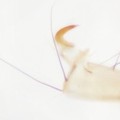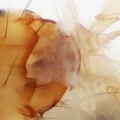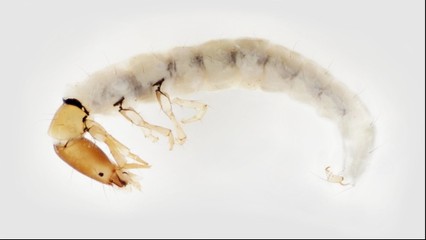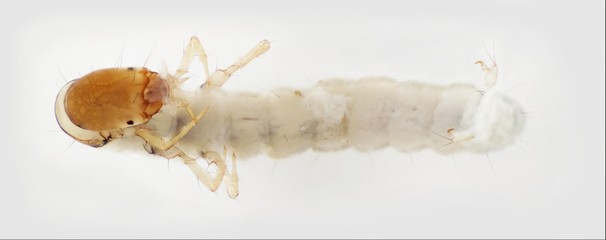order

Coleoptera
“Adult Beetles”

Coleoptera
“Larval Beetles”

Diptera
“True Flies”

Ephemeroptera
“Mayflies”

Hemiptera
“True Bugs”

Lepidoptera
“Aquatic Caterpillars, Snout Moths”

Megaloptera
“Alderflies, Dobsonflies, and Fishflies”

Odonata
“Dragonflies and Damselflies”

Plecoptera
“Stoneflies”

Trichoptera
“Caddisflies”
family
Philopotamidae
genus
Chimarra
“Finger-net Caddisflies”
Genus Overview
The larvae of this species are usually yellow or light orange in color, but turn white when preserved in ethanol. They live in warmer rivers where the larvae spin net-like retreats, used to filter detritus from the water for food. Sometimes the mesh is uniformly spaced, like other net spinners, but usually the mesh of these retreats is dense and irregular. The nets also tend to be clustered in groups of 5 or 6, and are found in crevices on the undersides of rocks, where the water can channel through. Fly-fishing enthusiasts sometimes tie their flies to mimic these larvae; they refer to them as yellow or orange caddisworms. The larvae can be distinguished from other genera in the family by the very asymmetrical, large notch at the anterior margin of the frontoclypeus.
Characteristics
POLLUTION TOLERANCE
Southeast: up to 2.8
Upper Midwest: up to 4
Midwest: up to 2.6
Mid-Atlantic: up to 4
0 = least tolerant, 10 = most tolerant
FEEDING HABITS
Collector / Filterer
MOVEMENT
Clinger
DISTRIBUTION
Widespread (east of the Rocky Mtns.)
HABITAT
Lotic-erosional
Diagnostic Characters
Order

Prolegs With Single Hook
Family

T-Shaped Labrum
+ Expanded Character List
Order:
Larvae: Wings/wing pads absent. Eye spots present, but compound eyes absent. Antennae usually small, inconspicuous. Three pairs of segmented legs present on thorax. Pair of anal prolegs, each with single hook, located on last abdominal segment. Larvae can be free-living, in silken retreats attached to substrate, or in usually-portable tubes or cases made of sand, rocks, or plant material.
Family:
Labrum membranous and T-shaped, in preserved specimens often sucked into mouth and hidden from view. Antennae small, nub-like, and inconspicuous. Pronotum sclerotized, but without anterolateral lobes. Meso- and metanota membranous. Abdominal tergum 9 entirely membranous. Larvae spinning stationary sac-shaped silken nets for filter feeding on undersides of rocks.
Genus:
Frontoclypeus with conspicuous, jagged asymmetrical notch on anterior margin. Seta no. 18 on ventral surface of head positioned level with posterior point of ventral apotome. Foretrochantins small and barely projecting away from body. Long, slender, setae-bearing process positioned subapically on each prothoracic coxa.


Lateral
Ventral




